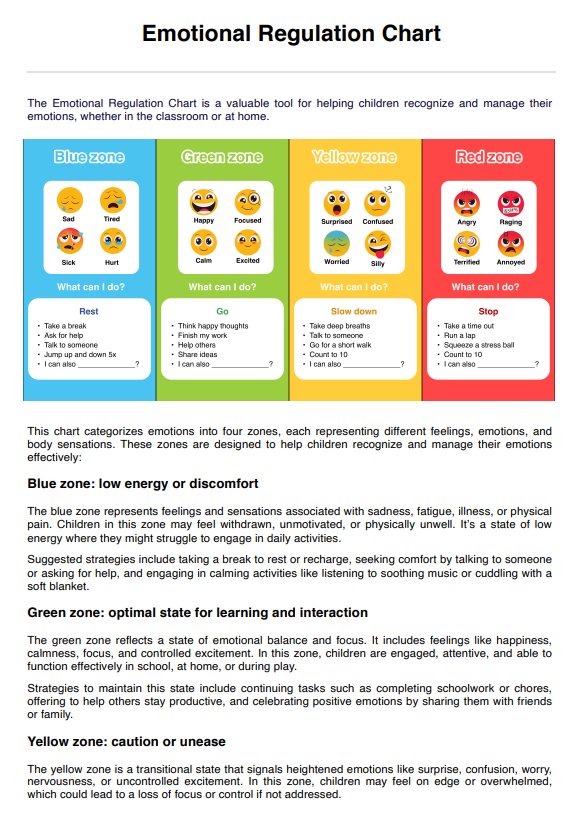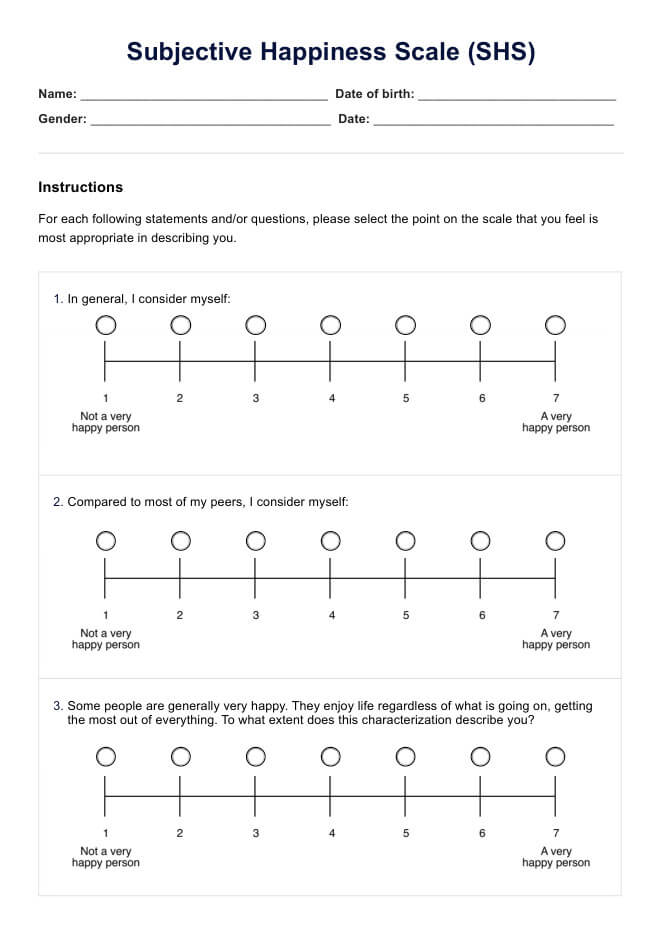Rivermead Mobility Index
Explore the Rivermead Mobility Index with our comprehensive guide and template, designed to improve mobility assessment accuracy in clinical settings.


What is functional movement?
Functional movement (also known as functional mobility) involves the ability to move the body with proper muscle and joint function for effortless, pain-free movement. These movements are fundamental to our daily activities, and understanding them is crucial for diagnosing, treating, and preventing injuries, particularly in healthcare and rehabilitation settings.
Importance of functional mobility
Functional movement is essential because it reflects our basic mechanics and health. Proper functional movement allows individuals to perform everyday activities efficiently and safely without strain or injury. It plays a vital role in maintaining general health, enhancing motor function, and improving quality of life. For older adults or those recovering from injuries or acute stroke, optimizing functional movement can significantly contribute to maintaining independence and preventing falls, which are common causes of serious injury.
Additionally, functional movement screening and training are increasingly used in sports and physical therapy to assess athletes' readiness to return to sports and to tailor rehabilitative exercises that address movement deficiencies. This approach helps to build a foundation for enduring physical fitness and reduces the risk of injury by emphasizing proper movement patterns and muscle activations.
Rivermead Mobility Index Template
Rivermead Mobility Index Example
What is the Rivermead Mobility Index?
The Rivermead Mobility Index (RMI) is an extension of the Rivermead motor assessment and is a standardized measure used for assessing ambulation levels of patients, particularly those recovering from strokes, traumatic brain injury, or other conditions affecting motor functions. Developed by researchers at the Rivermead Rehabilitation Centre in Oxford, England, the RMI comprises 15 items (also known as mobility measures) that evaluate different aspects of mobility, from simple tasks like turning over in bed to more complex activities like running.
To conduct the test, the examiner simply asks the questions and asks the patient to perform the associated actions. They then mark the relevant response based on the patient's mobility limitations, abilities, and responses.
Scoring
The Rivermead Mobility Index is scored based on a simple yes or no system, where each task performed independently by the patient without assistance scores a point. The total score can range from 0, indicating complete immobility, to 15, representing full mobility. This scoring system allows clinicians to quantify a patient's progress over time, making it an invaluable tool for tracking recovery and adjusting treatment plans.
What are the next steps?
Once the Rivermead Mobility Index assessment is complete, the next steps typically involve:
- Analyzing the results to identify specific areas where the patient may need more focused rehabilitation or support.
- Developing a personalized rehabilitation program based on the patient's specific needs and abilities as identified through the RMI.
- Regular re-assessment using the RMI to monitor the patient's progress and make adjustments to the rehabilitation program as necessary.
- Collaborating with other healthcare professionals to ensure a comprehensive approach to patient care.
- Educating the patient and family about the recovery process and expected outcomes, enhancing their engagement and compliance with the treatment plan.
This structured approach ensures that each patient receives tailored care that maximizes their recovery potential, thereby improving overall outcomes in mobility and independence.
How does our Rivermead Mobility Index template work?
Our Rivermead Mobility Index template is designed to streamline the process of conducting and documenting mobility assessments in clinical settings. This tool is essential for health professionals who require an efficient and accurate method to assess and track patient mobility over time.
Step 1: Access this template
Healthcare professionals can easily access our Rivermead Mobility Index template through the Carepatron app or on our website's template library. Available for both digital use and printing, the template is versatile and can be used in various settings, ensuring it is readily available whenever needed. You can even customize it on the app for your specific needs.
Step 2: Explain the template
Before beginning the assessment, it's crucial for practitioners to explain the purpose and structure of the template to the patient. This includes discussing the assessment items and how the responses will be recorded. Ensuring everyone understands the process helps in obtaining accurate results and enhances patient cooperation.
Step 3: Prepare for the assessment
Use the pre-assessment checklist included in the template to ensure all necessary conditions are met before beginning the test. This includes confirming no recent surgeries or injuries that might affect the assessment, ensuring the examination room is appropriately set up, and verifying that the patient understands the instructions.
Step 4: Conduct the assessment
Follow the structured format provided in the template to perform the Rivermead Mobility Index assessment. This involves asking the patient to perform each of the 15 tasks, observing their ability, and recording the results accordingly. Each task is designed to measure different aspects of mobility, and the practitioner's role is to assess and note the patient's performance accurately.
Step 5: Document the findings
Record the findings in the designated sections of the template. This includes marking whether each task was completed successfully and noting any observations or challenges encountered during the assessment. Proper documentation is crucial for tracking progress over time and making informed decisions about the patient's rehabilitation needs.
Benefits of using our template
Using the Rivermead Mobility Index template from Carepatron offers distinct advantages for healthcare professionals aiming to optimize mobility assessments. Here’s how it adds value:
- Streamlined assessments: This template provides a clear format for the Rivermead Mobility Index, ensuring that evaluations are conducted thoroughly and consistently. It helps prevent missing or overlooking crucial details, promoting accuracy and efficiency.
- Improved documentation: It features dedicated fields for recording all mobility tasks and additional observations, making it easier to track patient progress, share findings with other professionals, and maintain detailed patient records.
- Enhanced patient understanding: A standardized template clarifies the assessment process for patients, improving their understanding and engagement. Clear communication is key for motivating patients throughout their rehabilitation.
- Consistency across care: The uniform assessment method aids in maintaining consistency, especially in multi-provider settings, ensuring that all team members have a common understanding and approach to patient mobility evaluations.
- Educational tool: The template also serves as a practical training resource for new staff, students, patients, and their caretakers, illustrating proper assessment techniques and interpretations of the Rivermead Mobility Index.
The template not only streamlines workflow but also ensures precise and uniform patient care, enhancing both patient outcomes and operational efficiency in healthcare settings.
Commonly asked questions
The Rivermead Mobility Index (RMI) is an evaluative tool used primarily by healthcare professionals to assess the mobility of individuals recovering from stroke or other conditions affecting their movement. It measures various aspects of mobility through self-reported items and one direct observation.
Scoring the Rivermead Mobility Index involves assigning a point for each task the patient can perform independently, with a total of 15 points available. Higher scores indicate better mobility, which is important to know in stroke rehabilitation and planning.
The Modified Rivermead Mobility Index is highly reliable for assessing mobility in chronic stroke patients, with excellent inter-rater and intra-rater reliability (intraclass correlation coefficient up to 0.99 and K values up to 0.96), and a required change of more than 4.5 points to reflect true mobility changes.


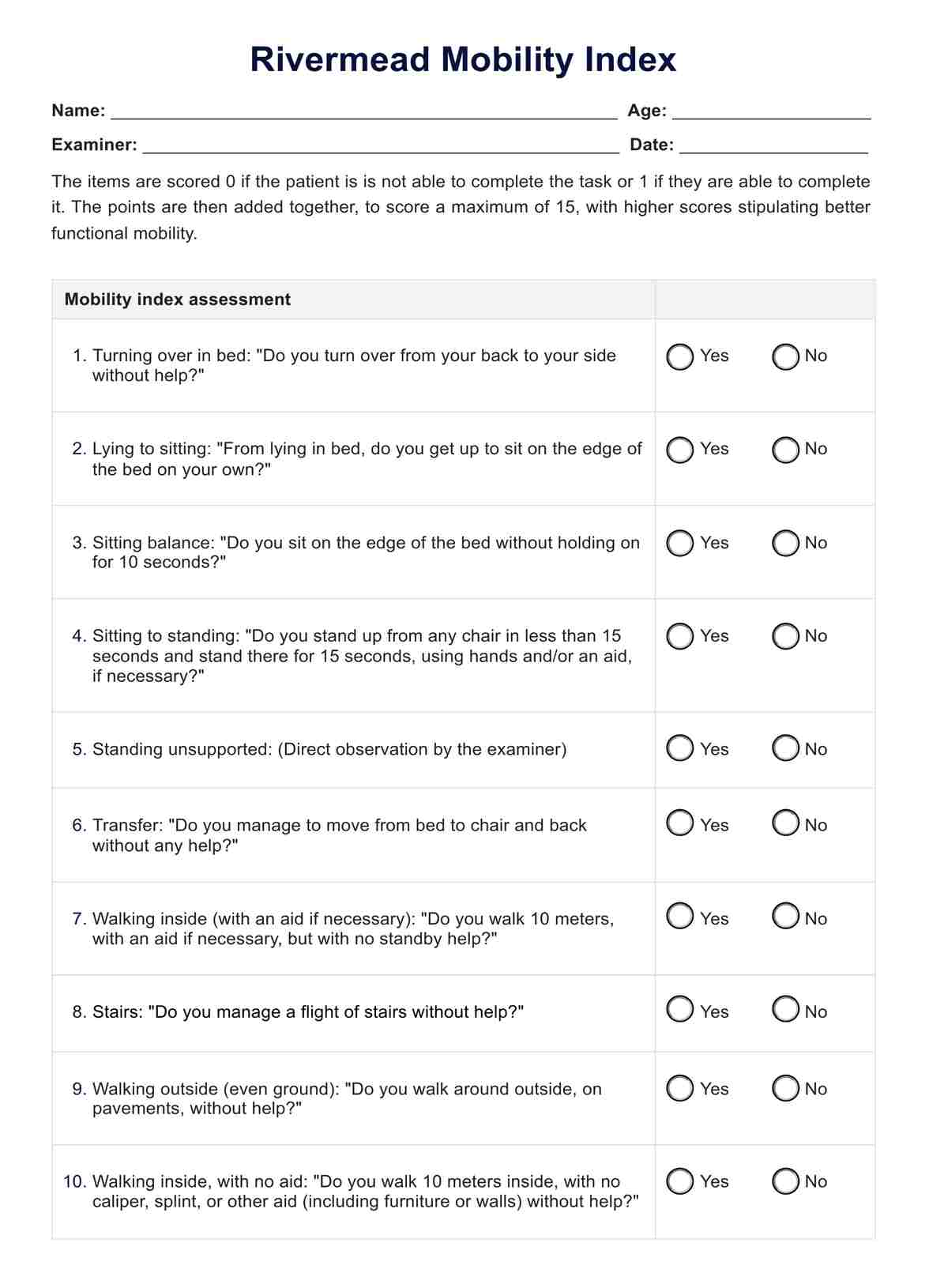
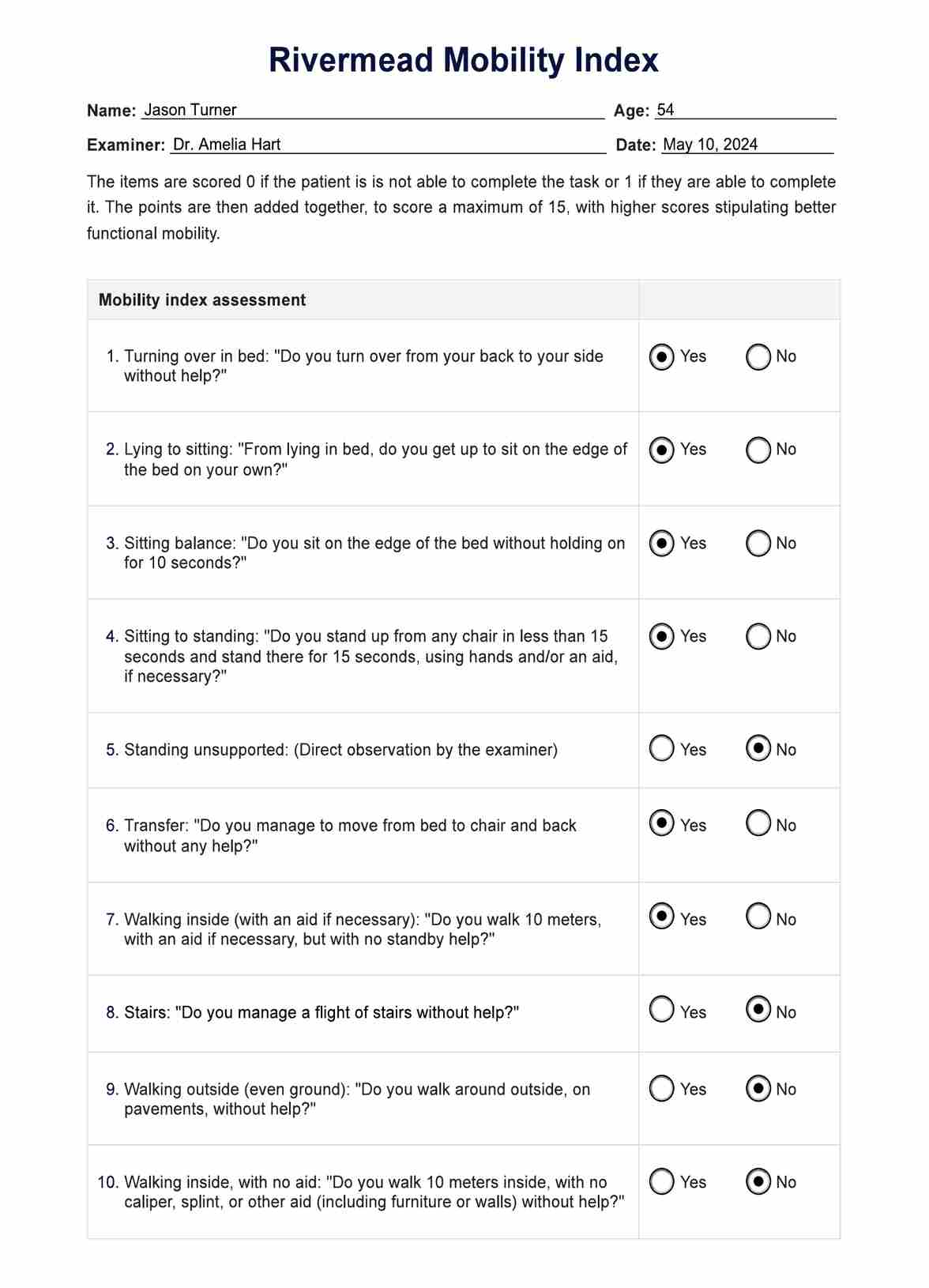

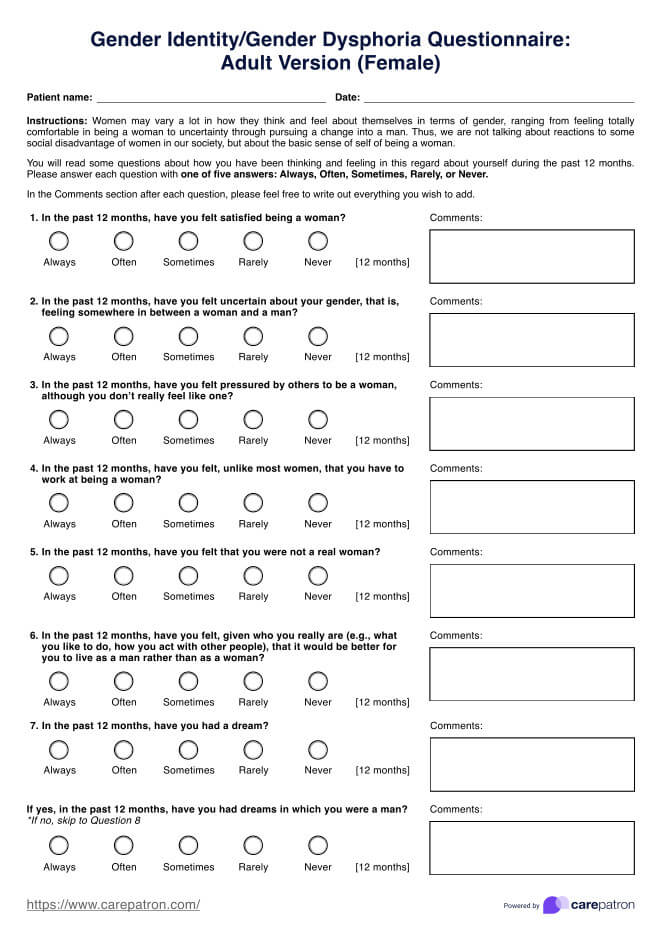
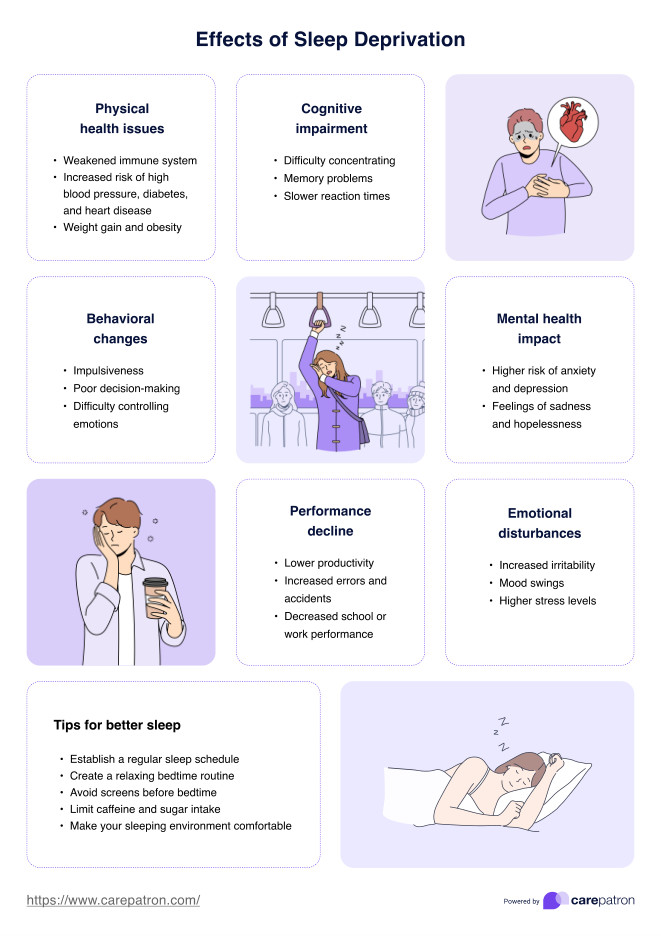
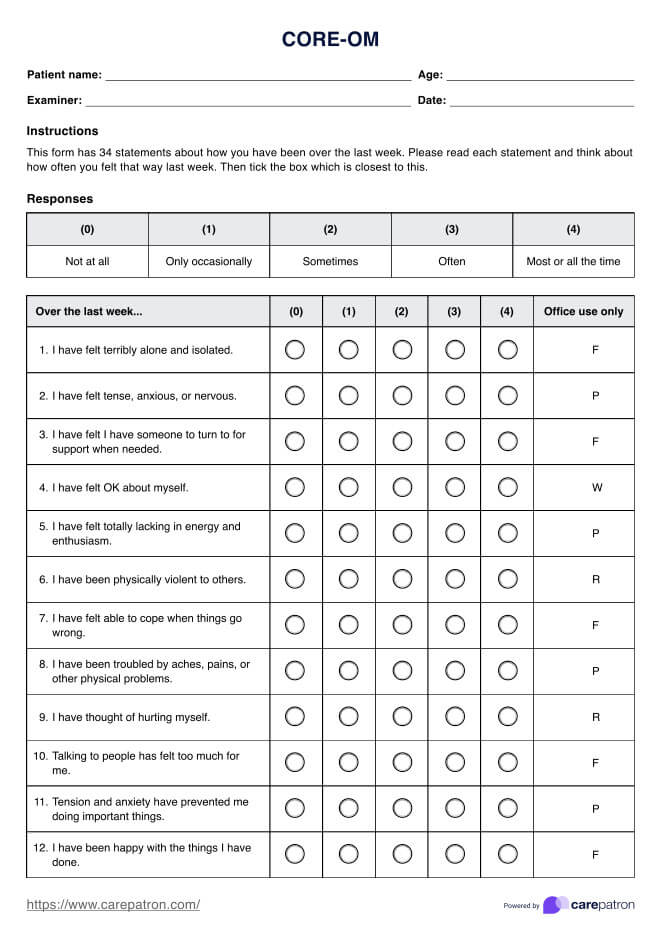











-template.jpg)






